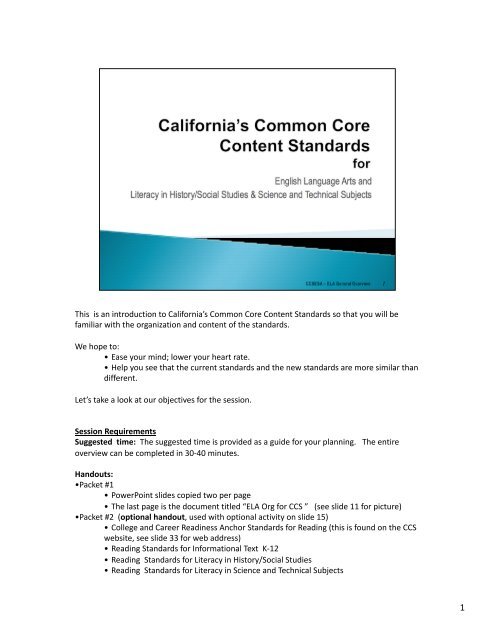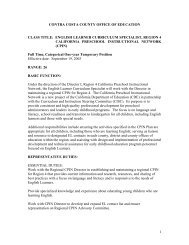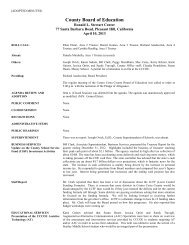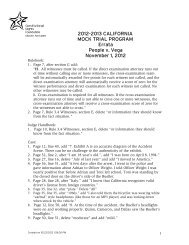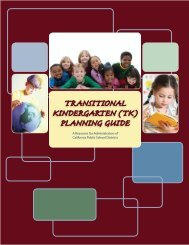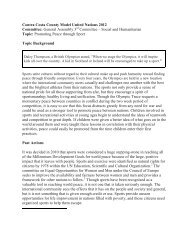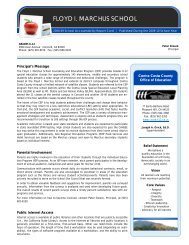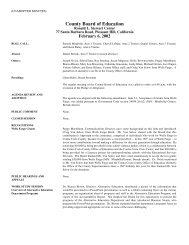Create successful ePaper yourself
Turn your PDF publications into a flip-book with our unique Google optimized e-Paper software.
This is an introduction to California’s Common Core Content Standards so that you will be <br />
familiar with the organization and content of the standards. <br />
We hope to: <br />
• Ease your mind; lower your heart rate. <br />
• Help you see that the current standards and the new standards are more similar than <br />
different. <br />
Let’s take a look at our objectives for the session. <br />
Session Requirements <br />
Suggested time: The suggested time is provided as a guide for your planning. The entire <br />
overview can be completed in 30‐40 minutes. <br />
Handouts: <br />
• Packet #1 <br />
• PowerPoint slides copied two per page <br />
• The last page is the document titled “ELA Org for CCS ” (see slide 11 for picture) <br />
• Packet #2 (optional handout, used with optional activity on slide 15) <br />
• College and Career Readiness Anchor Standards for Reading (this is found on the CCS <br />
website, see slide 33 for web address) <br />
• Reading Standards for Informational Text K‐12 <br />
• Reading Standards for Literacy in History/Social Studies <br />
• Reading Standards for Literacy in Science and Technical Subjects <br />
1
We’ll begin with a general overview to help you understand the key design <br />
considerations used by the “architects” as they crafted these standards, <br />
including the additional 15% California added to the Common Core. <br />
Next, we’ll explain the organization of the standards and familiarize you <br />
with the terminology used in the new standards. <br />
We’ll also highlight similarities between the two sets of standards as well <br />
as some of the shifts or differences. <br />
Finally, we’ll point out the areas of emphasis in the new standards. <br />
2
The architects of the standards framed the work by keeping the following <br />
goal in mind: All students are college and career ready in literacy by no <br />
later than the end of high school. <br />
The standards provide a vision of what it means to be a literate person in <br />
the twenty‐first century and develop the skills in reading, writing, speaking, <br />
and listening that are foundational for any creative and purposeful <br />
expression in language. <br />
3
The design of the standards set requirements for English Language Arts <br />
AND Literacy in History/Social Studies & Science and Technical Subjects <br />
(we’ll explore the details of these sections later). <br />
4
Key design considerations are outlined in the Introduction of the Common Core State <br />
Standards. You can read more detail on your own at a later time if you download the document <br />
from the Common Core State Standards website (see last slide for web address). The <br />
Introduction was not included in California’s adoption. <br />
• College and Career Readiness (CCR) anchor standards <br />
o The CCR standards anchor the document and define general, cross‐disciplinary <br />
literacy expectations that must be met for students to be prepared to enter college and <br />
workforce training programs ready to succeed. <br />
o California did NOT include the anchor standards; however, they are the framework <br />
around which the standards are organized. <br />
• Grade levels for K‐8; grade bands for 9‐10 and 11‐12 <br />
o K‐8 are grade‐level specific. <br />
o 9/10 and 11/12 are two‐year bands. <br />
• A focus on results rather than means <br />
o Standards leave room for determination of how goals should be reached and what <br />
additional topics should be addressed. <br />
• An integrated model of literacy <br />
o Standards are divided into Reading, Writing, Speaking & Listening, and Language <br />
strands for conceptual clarity, yet document reflects their interconnectedness. <br />
• Research and media skills integrated into the Standards as a whole <br />
o Research and media skills and understandings are embedded throughout the <br />
standards rather than treated in a separate section. We’ll show you some examples of <br />
this later. <br />
• Shared responsibility for students’ literacy development <br />
o Students’ literacy development is not only the responsibility of the ELA teachers; <br />
teachers in other areas have a role in this development as well. This expectation will <br />
become clearer as we explain the structure of the standards. <br />
• Focus and coherence in instruction and assessment <br />
o While the Standards delineate specific expectations in reading, writing, speaking, <br />
listening, and language, each standard need not be a separate focus for instruction and <br />
assessment. Often, several standards can be addressed by a single rich task. <br />
5
The Introduction of the Common Core State Standards also describes what <br />
is NOT covered by the standards, the Intentional Design Limitations. <br />
The Standards do… <br />
• set grade‐level standards; they do not define the intervention <br />
methods or materials <br />
The Standards do… <br />
• allow for the widest possible range of students to participate fully <br />
permitting appropriate accommodations; they do not define the full <br />
range of supports appropriate for English learners and students with <br />
special needs <br />
The Standards do… <br />
• define general, cross‐disciplinary literacy expectations; they do not <br />
define the whole of college and career readiness <br />
6
The Intentional Design Limitations continue with the following: <br />
The Standards do… <br />
• define what all students are expected to know and be able to do; <br />
they do not define how teachers should teach <br />
The Standards do… <br />
• focus on what is most essential; they do not describe all that can or <br />
should be taught <br />
The Standards do… <br />
• establish a baseline for advanced learners; they do not define the <br />
nature of advanced work <br />
7
States could add up to 15% to the Common Core State Standards <br />
developed by the State Standards Initiative consortium. <br />
California added to the common core state standards based on the <br />
following criteria: <br />
• Substantively enhance <br />
• Address a perceived gap <br />
• Be defensible to classroom practitioners <br />
• Keep the original standard intact <br />
• Ensure the rigor of California’s existing standards is maintained <br />
In order to identify what was added, the Commission presented a draft to <br />
the State Board of Education with California’s Additional 15% indicated in <br />
bold and underlined font. <br />
The architects of the Common Core combined the best work of states. In <br />
fact, California’s standards played a large part in developing the foundation <br />
for the Common Core. Because of this, California did not necessarily add <br />
the full 15% that was allowed. In terms of word count for ELA, California <br />
added approximately 8%. <br />
8
California’s additional 15% includes the following: <br />
• Analysis of text features in informational text (Gr. 6‐12): For example, in grade 6 <br />
”Analyze the use of text features (e.g., graphics, headers, captions) in popular media” was <br />
added to Standard 5 to add specificity. <br />
• Included Career and Consumer Documents in Writing (Gr. 8): Career and consumer <br />
documents were not specifically called out in the Common Core. Therefore, “including <br />
career development documents (e.g., simple business letters and job applications)” was <br />
added to a CCS standard in order to add specificity. <br />
• Application of phonics and word analysis skills both in isolation and in text (Gr. K‐3): <br />
This was added to ensure that students were expected to apply these skills BOTH in <br />
isolation and in text. <br />
• Penmanship added to Language (Gr. 2‐4): CCS only included specific standards <br />
addressing penmanship in Kindergarten and Grade 1. <br />
• Formal presentations in Speaking and Listening (Gr. 1‐12): CCS placed more emphasis <br />
on collaborative conversations, formal presentations were specifically called out in the <br />
additional 15% – “Plan and deliver an informative/explanatory presentation…” <br />
• Minor additions and insertions to clarify (e.g., archetypes, thesis). <br />
Obviously, this is not an exhaustive list. Remember, in order to identify what was added, <br />
the Commission presented a draft to the Board with California’s additional 15% indicated <br />
in bold and underlined font. <br />
9
Let’s begin exploring the organization of the standards. <br />
The ELA standards are organized into three main sections. <br />
• A comprehensive K‐5 section; History/Social Studies & Science and <br />
Technical Subjects are embedded in these standards since <br />
instruction is typically provided by one teacher. <br />
• Two content‐area specific sections for grades 6‐12 <br />
• English Language Arts <br />
• History/Social Studies & Science and Technical Subjects (this <br />
will be explained in more detail later) <br />
There are four strands in the Common Core State Standards (the “strands” <br />
are called “domains” in the current CA standards): <br />
• Reading <br />
• Writing <br />
• Speaking and Listening (K‐12 ELA only – not included in the <br />
History/Social Studies & Science and Technical Subjects section) <br />
• Language: this strand includes conventions and vocabulary. (K‐12 <br />
ELA only – not included in the History/Social Studies & Science and <br />
Technical Subjects section) <br />
10
Find the handout at the back of your packet which outlines the organization of each strand. <br />
There are three sets of standards in the Reading Strand: Reading Standards for Literature, Reading <br />
Standards for Informational Text, and Reading Standards: Foundational Skills. <br />
In the first two sets, subheadings are consistent across grade levels: <br />
• Key Ideas and Details <br />
• Craft and Structure <br />
• Integration of Knowledge and Ideas <br />
• Range and Level of Text Complexity <br />
The third set of standards in the Reading Strand is Foundational Skills, included in K‐5 only. The <br />
subheadings are: <br />
• Print Concepts <br />
• Phonological Awareness <br />
• Phonics and Word Recognition <br />
• Fluency <br />
The Writing Strand includes one set of standards, and the subheadings are consistent across grade levels: <br />
• Text Types and Purposes <br />
• Production and Distribution of Writing <br />
• Research to Build and Present Knowledge <br />
• Range of Writing <br />
Speaking and Listening is one set of standards as well. Again, subheadings are consistent across grade <br />
levels: • Comprehension and Collaboration <br />
• Presentation of Knowledge and Ideas <br />
Finally, the Language Strand is one set of standards with consistent subheadings across grade‐levels: <br />
• Conventions of Standard English <br />
• Knowledge of Language <br />
• Vocabulary Acquisition and Use <br />
You may notice that Vocabulary is in the Language Strand of the Common Core, while in our current <br />
standards it is in the Reading domain. We’ll explore this shift later in the presentation.<br />
11
Here is a page taken from the K‐5 section of the standards. <br />
Instructor Note: Use the following questions to highlight important information on the <br />
slide. <br />
The standards on this page are from which strand? Reading <br />
Which set of standards in the Reading strand? Informational Text <br />
How many standards are in the Reading Standards for Informational Text across ALL <br />
grade levels? Ten <br />
What are the consistent subheadings? Key Ideas and Details; Craft and Structure; <br />
Integration of Knowledge and Ideas; Range of Reading and Level of Text Complexity <br />
What does the bold an underlined text in standard 4 and 10 indicate? Part of the 15% <br />
added by California <br />
12
Next, we’ll look at a standard to explore the organization of standards <br />
across grade levels. <br />
Remember, the Common Core State Standards were developed to build <br />
towards College and Career Readiness, using anchor standards to guide the <br />
progression across grade levels. While California did not include the CCR <br />
anchor standards, they are central to the organization– they are the <br />
framework used to design these standards and you will see how the <br />
knowledge and skills develop across grade levels. <br />
Remember the four strands identified on the handout. For each strand, <br />
anchor standards were used to organize the progression of standards <br />
across grade levels. <br />
• Reading: 10 anchor standards <br />
• Writing: 10 anchor standards <br />
• Speaking & Listening: 6 anchor standards <br />
• Language: 6 anchor standards <br />
13
What we’d like you to notice is how the numbers of the standards are <br />
consistent across grade‐levels, with the purpose of developing a particular <br />
knowledge or skill. At the top of the slide is the anchor standard from the <br />
Common Core. Note how the development of this standard progresses <br />
across grade levels. <br />
For example, In the Reading: Informational Text set of the standards, <br />
Standard 2 works toward the College and Career Readiness anchor <br />
standard “Determine central ideas or themes of a text and analyze their <br />
development; summarize the key supporting details and ideas.” <br />
Look at kindergarten, Grade 2, 4, 6, 8, and 11/12 on this and the following <br />
slide. You will see the progression across grade levels. While the anchor <br />
standards are not included in California’s adoption, the underlying <br />
structure remains. Therefore, the number used to reference each of the <br />
standards remain consistent across grade levels. <br />
14
CONTINUED <br />
Optional Activity (use packet #2) <br />
1. Review the College and Career Readiness Anchor Standards for Reading. <br />
2. Choose one of the Reading Standards for Informational Text. <br />
3. Trace that standard grades K‐12. Also trace it grades 6‐12 in the Reading <br />
Standards for Literacy for History/Social Studies AND Reading Standards for <br />
Literacy in Science and Technical Subjects. <br />
4. Share your observations with a partner. <br />
15
Now, we’ll take a look at some of the similarities between California’s <br />
current standards and the newly adopted Common Core Standards for <br />
California. <br />
California’s current standards are organized into four large categories <br />
called domains. The domains are: <br />
• Reading <br />
• Writing <br />
• Listening and Speaking <br />
• Written and Oral English Language Conventions <br />
The Common Core Standards for California are similarly organized into four <br />
groups called strands. The strands are: <br />
• Reading <br />
• Writing <br />
• Speaking and Listening <br />
• Language <br />
Let’s take a closer look at some of the standards and note their similar <br />
content. <br />
16
Compare California’s current standards with the Common Core Standards <br />
for California on this and the following two slides. Note the similarities in <br />
the content of the standards. <br />
17
CONTINUED <br />
18
CONTINUED <br />
Point out the bold and underlined text used to indicate California’s <br />
additional 15%. <br />
19
While the content of the standards is very similar, the placement within <br />
the organization of the standards may have shifted. <br />
You’ll note that in our current standards, vocabulary standards are found in <br />
the Reading Domain, while in the Common Core Standards for California, <br />
they are now in the Language Strand. <br />
Standards addressing conventions and grammar are in the Written and <br />
Oral English Language Conventions Domain of our current standards. These <br />
standards are now found in the Language Strand. <br />
It is important to keep these shifts in mind when comparing the two sets of <br />
standards. <br />
20
Let’s take a look at some shifts in Writing Applications. <br />
While our current standards specifically identify various writing <br />
applications across grade levels, the Common Core Standards for California <br />
organize the writing applications into three categories: <br />
1. Write Opinions (K‐5); Write Arguments (6‐12) <br />
2. Write Informative/Explanatory Texts <br />
3. Write Narratives <br />
If you compare the two lists, you will see that the various writing <br />
applications found in our current standards fit into one of the three <br />
categories of the Common Core Standards for California. <br />
21
One reason for this shift in the organization of writing standards is to <br />
better prepare students for college and career writing. This shift matches <br />
the NAEP (National Assessment of Educational Progress) framework. <br />
Notice the decreasing emphasis on writing to convey an experience <br />
(narrative) and the increase in writing to persuade or explain. <br />
22
Another shift is a more overt emphasis on shared responsibility for students’ literacy development. This <br />
was already part of California’s ELA and subject frameworks. These standards make the shared <br />
responsibility more overt. Our current History and Science frameworks already include many of the <br />
standards – so it is not really new to teach reading and writing in the subject areas. In fact, History and <br />
Science materials were recently adopted, so many districts have instructional materials in these content <br />
areas that do a good job of teaching and incorporating reading and writing. <br />
Instructor Note: Paraphrase the following paragraphs from the Introduction p. 2. <br />
The Standards insist that instruction in reading, writing, speaking, listening, and language be a shared <br />
responsibility within the school. The K–5 standards include expectations for reading, writing, speaking, <br />
listening, and language applicable to a range of subjects, including but not limited to ELA. The grades 6–<br />
12 standards are divided into two sections, one for ELA and the other for history/social studies, science, <br />
and technical subjects. This division reflects the unique, time‐honored place of ELA teachers in <br />
developing students’ literacy skills while at the same time recognizing that teachers in other areas must <br />
have a role in this development as well. <br />
Part of the motivation behind the interdisciplinary approach to literacy promulgated by the Standards is <br />
extensive research establishing the need for college and career ready students to be proficient in reading <br />
complex informational text independently in a variety of content areas. Most of the required reading in <br />
college and workforce training programs is informational in structure and challenging in content; <br />
postsecondary education programs typically provide students with both a higher volume of such reading <br />
than is generally required in K–12 schools and comparatively little scaffolding. <br />
Let’s take a look at who is responsible for which portion of the Standards. <br />
• In K‐5, since most of the instruction students receive comes from one teacher, there is a single set of <br />
grade‐specific standards for which the classroom teacher is responsible. <br />
• In grades 6‐12, there is one set of standards for which ELA teachers are responsible. <br />
• Another set of literacy standards for history/social studies, science, and technical subjects includes <br />
standards for which responsibility must be shared between ELA teachers and teachers in other content <br />
areas. <br />
• The literacy standards in history/social studies, science, and technical subjects are meant to <br />
complement rather than supplant content standards in those disciplines; the point is that there are <br />
discipline‐specific literacy skills that should be addressed in other content areas. <br />
23
Let’s look at some areas of emphasis in the Common Core State Standards. <br />
As we begin looking towards new assessments in 2014‐15, we want to <br />
teach with an awareness of what is emphasized in the Common Core <br />
standards. <br />
These standards: <br />
• Focus on text complexity <br />
• Address reading and writing across the curriculum <br />
• Emphasize analysis of informational text <br />
• Focus on writing arguments and drawing evidence from sources <br />
• Emphasize participating in collaborative conversation <br />
• Integrate media sources across standards <br />
Let’s see what is meant by each of these statements. <br />
24
Reading Standard 10 references a text complexity band beginning in <br />
Grade 2. <br />
Text complexity takes into account three factors: <br />
• Qualitative evaluation of the text: Levels of meaning, structure, <br />
language conventionality and clarity, and knowledge demands <br />
• Quantitative evaluation of the text: Readability measures and <br />
other scores of text complexity <br />
• Matching reader to text and task: Reader variables (such as <br />
motivation, knowledge, and experiences) and task variables (such <br />
as purpose and the complexity generated by the task assigned and <br />
the questions posed) <br />
You will find more information on text complexity within the body of the <br />
standards (two pages that follow the K‐5 and the 6‐12 ELA standards) and <br />
in Appendix A (research) and Appendix B (illustrative texts) which were <br />
not included in California’s adoption. <br />
25
The standards emphasize reading and writing across curricular areas. You <br />
will see this reflected in these example standards from Grade 5 and Grades <br />
9‐10. <br />
26
CONTINUED <br />
Presenter note: Reminder of the organization of the standards <br />
• Reading Standards for Literacy in History/Social Studies <br />
• Reading Standards for Literacy in Science and Technical Subjects <br />
(two separate sections) <br />
• Writing Standards for Literacy in History/Social Studies and Science <br />
and Technical Subjects (one combined section) <br />
27
An awareness of the emphasis on Informational Text is critical in ensuring <br />
student success. <br />
The standards aim to align with NAEP in the distribution of literary and <br />
informational text. This emphasis on informational text must begin K‐3, <br />
because as you can see, by Grade 4 the distribution is 50/50. <br />
Note that literary non‐fiction is included in the Literary category, and this <br />
includes essays, speeches, and biographies. Therefore, the actual volume <br />
of informational text may be even higher than what is outlined in this <br />
table. <br />
It is important to note that the high percentages of informational text in <br />
high school is a shared responsibility between ELA teachers and teachers in <br />
other disciplines. This does not mean that all 70% of informational reading <br />
needs to happen in the ELA classrooms. <br />
28
This sample from seventh grade is just one example. As with all of the <br />
standards, there is a progression across grade levels. <br />
29
California’s current standards place more of an emphasis on formal <br />
presentation. The Common Core Standards add an emphasis on <br />
collaborative conversations; a skill that one might argue is used on an <br />
everyday basis. <br />
Here is an example of a Speaking and Listening standard addressing <br />
Collaborative Conversation. Take a moment to read the standard. <br />
Presenter note: One formal speech is called out at each grade level. <br />
30
Another emphasis is on integrating media sources. Research and media skills are <br />
blended into the Standards as a whole. <br />
INSTRUCTOR NOTE: Paraphrase the following paragraph from the Introduction. <br />
To be ready for college, workforce training, and life in a technological society, <br />
students need the ability to gather, comprehend, evaluate, synthesize, and <br />
report on information and ideas, to conduct original research in order to answer <br />
questions or solve problems, and to analyze and create a high volume and <br />
extensive range of print and non‐print texts in media forms old and new. The <br />
need to conduct research and to produce and consume media is embedded <br />
into every aspect of today’s curriculum. In like fashion, research and media <br />
skills and understandings are embedded throughout the Standards rather than <br />
treated in a separate section. <br />
Let’s take a look at this integration into the standards as a whole. <br />
You’ll see from these Grade 6 examples, the use of media sources is integrated <br />
across the strands. Take a moment to read the example standards. <br />
These are only a few examples from Grade 6. It is important to note that this is <br />
not an exhaustive list; there are numerous examples of integration of media <br />
sources within each grade level across the strands. <br />
31
Throughout the presentation we have referenced the Introduction, College <br />
and Career Readiness anchor standards, and the Appendices, which were <br />
not included in California’s adoption. These documents may support your <br />
understanding of the organization and structure of the ELA standards and <br />
can be found at www.corestandards.org which is on the final slide. <br />
32
Allow a moment for comments and questions. <br />
33


